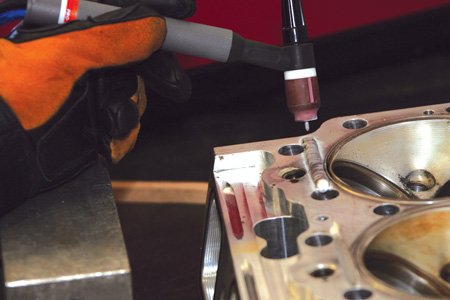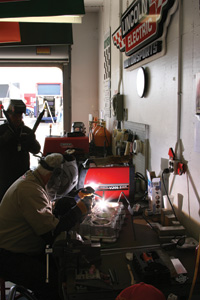Do you outsource cylinder head repairs that require welding? If so, you might be missing an opportunity to generate additional income for your shop and reduce turnaround time for customers. Here’s a look at how you can potentially increase profitability and productivity by bringing it in house.
Doing these kinds of welds successfully requires the right manpower and equipment. Since these repairs are typically performed with a TIG welding process, you need a trained TIG welder on staff. If you don’t have one, it might be worth training the right person. Luckily, training programs are easy to find by contacting your local community college or investigating specialized welding schools from suppliers.
The other part of the equation is having the right equipment and knowing the ins and outs of making weld repairs on cylinder heads. This article will discuss both in detail.
Cleaning & Preheating
Cylinder head conditions run a wide gamut, but most are old, dirty and compounded with oil, hydrocarbons and other residue from years of use. To begin, all these contaminants must be removed. Most shops have the tools to do this with ultrasonic cleaners or solvents.
The next step is preheating. The best heat source is an oven (it can be the same kind you would find in your kitchen). An oven allows you to better control the temperature of the part. If you don’t already have one, it’s worth the long-term investment.
When welding aluminum, temperature is always an issue. Cold material can create hot, short weld cracks. Too much heat can create soft spots. Heating the part in a 350°F oven helps prevent these problems. Another benefit of an oven is that the heat will help cook off remaining impurities that were missed or unable to be removed during cleaning.
TIG Welding Equipment & Parameters
The first step is to make sure you have the right TIG machine. Since welding is just one of many jobs you perform, make sure you choose a machine that is versatile, portable and gives you the necessary amperage range. Look for a machine with straight-forward, intuitive controls. And as you won’t likely have a space dedicated to welding, a machine that can easily be wheeled to where you are making repairs is important. Other machine characteristics to look for include technology that delivers superior arc performance, a clean start and stable arc control.
Having a TIG machine in your shop gives you great versatility to use it for other weld repairs. Additionally, many TIG machines also allow for stick welding, which you may need for from time to time.
Now, let’s talk about the actual welding. You’ll find the following parameters apply to about 90 percent of weld repairs. As most engine heads are aluminum A-356 or A-355 castings, TIG welding is the best process.
Typically, you’ll use a 3/32?-diameter tungsten. For 3/32?, you shouldn’t have to exceed 200 amps on your welder. If you need to go up to 250 amps, move up to a 1/8?-diameter tungsten. If the repair requires more than 250 amps, the part has likely cooled off and needs to be reheated.
Setting your TIG machine to AC mode, use a gas blend of 75 percent argon and 25 percent helium. Because helium is a hotter gas, its use allows your torch to be more efficient. Using just argon would require higher amperage. If possible, buy the gas blend premixed. This helps prevent the inclusion of too much of either gas, because too much helium can cause an unstable arc.
Typically, you want an air flow of 15 to 20 CFH, and the tungsten shouldn’t stick out any farther than 1/4?, providing better control of the weld.
Frequently, there are areas of the cylinder head that can be difficult to reach, such as the valve seats. In these instances, a standard torch won’t provide the reach you need. A low-profile torch allows you to make the weld and get out before the torch burns up. There are also cases when radiant heat can burn the rubber on your torch. You can extend the life of your torch by wrapping it in aluminum foil.
In most cases, use a 40/43 filler material. It has less crack sensitivity over a 53/56 material. Once you’ve made the repair, wrap the head in a thermal blanket. This allows it to cool slowly. If the part cools too quickly, you’ll find separation of the alloys in the weld, which directly affects the final quality and life of the weld.
What It Means To You
Bringing your engine head weld repairs in house gives your shop the opportunity for an additional profit center and adding value to your customers. With the right investment in manpower and equipment, you can not only increase your shop’s productivity but positively add to your bottom line.
Wyatt Swaim is a long-time TIG welding consultant to The Lincoln Electric Company. He has more than 30 years of experience and is known throughout the industry as “Mister TIG.” He regularly conducts advanced training seminars for the Experimental Aircraft Association (EAA) and motorsports teams and is part of the trackside welding team at the Indy 500. He has done IRL and CART race welding throughout the United States and Brazil and regularly demonstrates TIG welding at the American Welding Society show, the Essen Welding Show in Germany and the Canadian Welding Show. You can reach Wyatt at [email protected].














